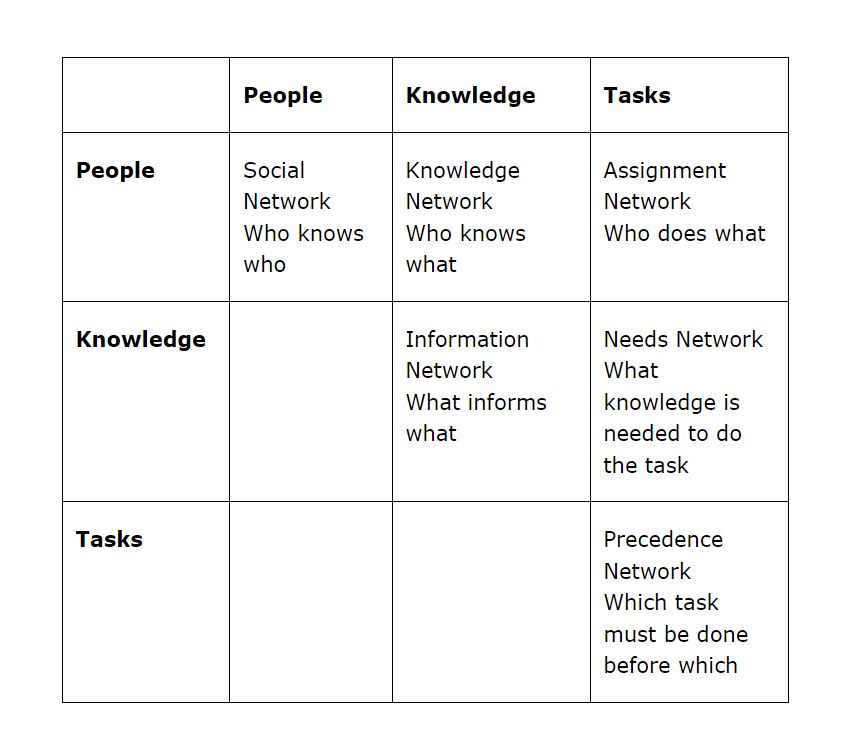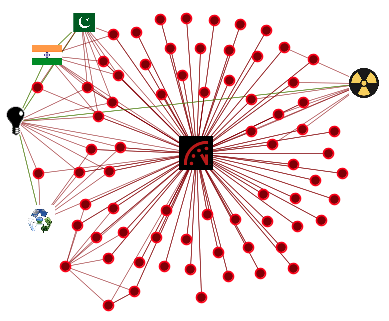ORA-LITE
ORA-LITE is a dynamic meta-network assessment and analysis tool developed by CASOS at Carnegie Mellon. It contains hundreds of social network, dynamic network metrics, trail metrics, procedures for grouping nodes, identifying local patterns, comparing and contrasting networks, groups, and individuals from a dynamic meta-network perspective. ORA-LITE has been used to examine how networks change through space and time, contains procedures for moving back and forth between trail data (e.g. who was where when) and network data (who is connected to whom, who is connected to where …), and has a variety of geo-spatial network metrics, and change detection techniques. ORA-LITE can handle multi-mode, multi-plex, multi-level networks. It can identify key players, groups and vulnerabilities, model network changes over time, and perform COA analysis. Although all metrics available in ORA-LITE have been tested with large networks (10^6 nodes per 5 entity classes); ORA-LITE is itself limited to a maximum of 2,000 nodes per entity class. So you can have 2000 agents, 2000 organizations, and so on. The Professional version of ORA which is available from Netanomics (www.netanomics.com) has no limit on the number of nodes. Distance based, algorithmic, and statistical procedures for comparing and contrasting networks are part of this toolkit.
Based on network theory, social psychology, operations research, and management theory a series of measures of “criticality” have been developed at CMU. Just as critical path algorithms can be used to locate those tasks that are critical from a project management perspective, the ORA-LITE algorithms can find those people, types of skills or knowledge and tasks that are critical from a performance and information security perspective. Each of the measures we have developed are calculated by ORA-LITE on the basis of network data like that in the following table.

ORA-LITE can be applied both within a traditional organization or on covert networks.
Latest Version Information
2) Stance detection report
a. Added the CUES table above to the Stance Detection report to show cues and group quality metrics.
3) Simplified the Table Data Import Wizard importer.
4) Data Import Wizard improvements:
5) Telegram importer and report changes:
6) JSON output for Node of Interest report.
7) Revised and updated the Missing Link report, which includes scalability, user-interface, and report layout improvements.
8) Semantic network report:
9) Parts of Speech and Communication Power report modifications:
10) Improved visualization capabilities
11) Underlying libraries updated
12) Miscellaneous bug fixes
Hardware Requirements
Hardware Requirements
- CPU with 500 megahertz or higher processor clock speed recommended (3 Ghz is recommended for large datasets)
* Intel Pentium/Celeron family, or AMD K6/Athlon/Duron family, or compatible processor recommended - 512 MB of RAM or higher recommended (1 GB preferred)
- 500 MB of available hard disk space
Notes on Multi-Core Processors
- ORA-LITE can take advantage of all the cores in your machine. All
computationally intense measures are multi-threaded.
System Interaction
- ORA-LITE has a java front end and a C++ backend. It does NOT touch the system registry.
Publications and Resources
- Altman, Neal & Carley, Kathleen M. (2022). ORA User's Guide 2022. Carnegie Mellon University, School of Computer Science, Institute for Software Research, Technical Report CMU-ISR-22-107, [pdf]
- Carley, Kathleen M. (2014). ORA: A Toolkit for Dynamic Network Analysis and Visualization, In Reda Alhajj and Jon Rokne (Eds.) Encyclopedia of Social Network Analysis and Mining, Springer.
- Ujawary-Gil, Anna (2019). Organizational Network Analysis: Auditing Intangible Resources. 1st Edition. Routledge. [link]
- ORA Quickstart Guide
- Using ORA with Social Media
- Description of ORA
Sponsors
|
-
|
The Office of Naval Research (ONR) |
| - | United States Navy Grant (ONR - MURI) No. N000140811186 |
| - | United States Navy Grant No. 9620.1.1140071 on Dynamic Network Analysis |
| - | United States Navy Grant No. 1681.12.1140053 on Adaptive Architecture for Command and Control |
| - | The Department of Defense |
|
-
|
The Defense Advanced Research Projects Agency (DARPA) INSIGHT project DAAH01-03-C-R111 |
|
-
|
National Aeronautics and Space Administration (NASA) |
|
-
|
The Army Research Lab (ARL), and ARL-CTA |
|
-
|
The National Science Foundation under NSF 0100999 doctoral dissertation grant, NSF ITR 0218466 NSF ITR/IM IIS-0081219, NSF KDI IIS-9980109, NSF 043 7239, NSF 045 2598, NSF 045 2487, and NSF IGERT 9972762 for research and training in CASOS. |
|
-
|
The Air Force Office of Scientific Research (AFOSR) under Grant 600322GRGMASON, Computational Modeling of Cultural Dimensions in Adversary Organization (MURI), with George Mason University. |
|
-
|
The Department of Defense (DOD) |
|
-
|
The Office of the Chief of Naval Operations (Op-Nav) |
|
-
|
The Office of National Drug Control Policy (ONDCP) |
|
-
|
Army Research Institute (ARI) |
|
-
|
Army Research Office (ARO) |
The views and conclusions contained in this document are those of the authors and should not be interpreted as representing the official policies, either expressed or implied, of the Office of Naval Research, the Department of Defense, the Army Research Lab, NASA, the National Science Foundation or the U.S. government.


